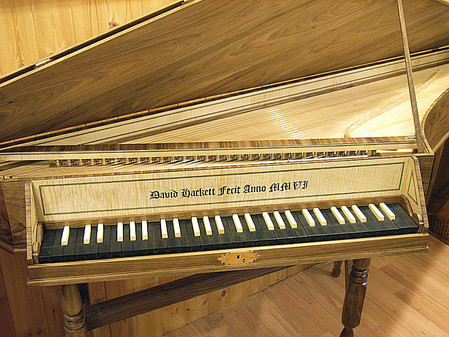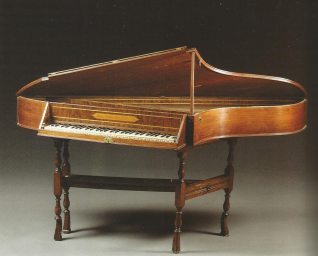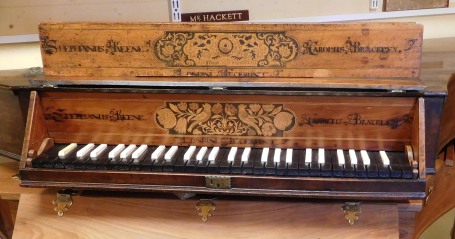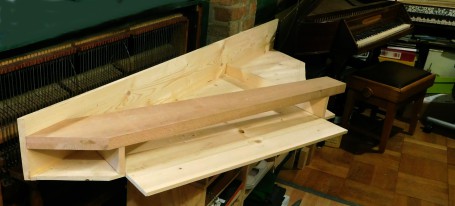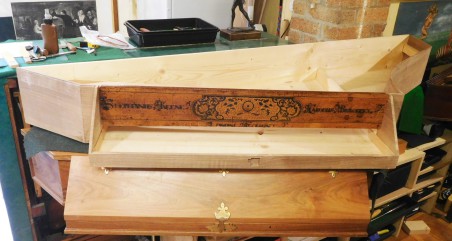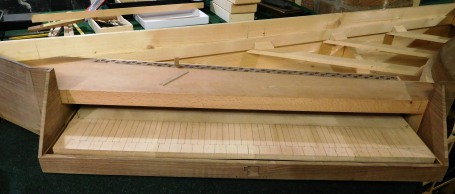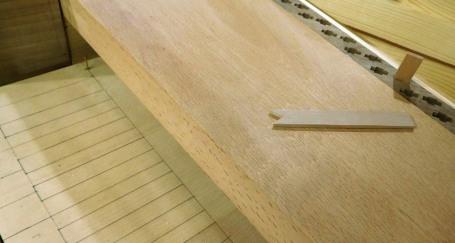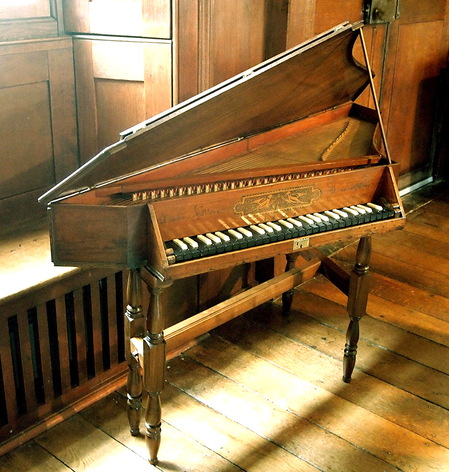
The Spinet Page
Perhaps these have always been my favourite instruments, but please don't tell my Square Pianos!
Relatively few original spinets turn up at auction, and prices are beyond the reach of most of us. However, it is not too difficult to make a decent spinet, and I hope that this page will encourage people to have a go. There used to be reasonably-priced kits available: the Early Music Shop's 'Keene & Brackley' and the freelance designs of John Storrs were good.
I f there's anything you'd like to ask, or just to show interest, please contact me, David, on friends.sp@btinternet.com
'1664' and Thomas Hitchcock
There are two Quite Interesting PDFs that you might enjoy reading:
Adobe Acrobat document [942.5 KB]
Adobe Acrobat document [881.4 KB]
A Keene & Brackley Realisation for the Sigal Music Museum
Friends may remember that it was my privilege to complete a definitive restoration of the famous Keene & Brackley spinet, in preparation for it to join the Sigal Music Museum in South Carolina. At around the same time, I became the owner of the only other known Keene & Brackley survival – the nameboard mentioned in Boalch, variously owned by Taphouse of Oxford, Alfred Hipkins, Henry Tull, and Mick Colt – so they were briefly reunited - see picture above.
I am pleased to say that a project is now in hand for me to build a replica spinet around this nameboard, which when complete will also go to the Sigal Music Museum. There it will be used for the museum’s splendid ‘Roadshows’ to schools and other groups of young people. There they will be able to enjoy literally hands-on experience of an early instrument, while the original can enjoy a quieter life at home in the museum.
Compared to a big harpsichord or even a square piano, a spinet is so much more practical: easier to carry about, reliable, and simple to tune.
A picture of the start of the project is attached; the curve of the right-hand side will be trimmed to fit the walnut bentside, and the beech wrestplank also trimmed to fit before being glued in place.
I’ll post occasional updates as the project makes progress.
There has been some debate over the date of the famous Keene & Brackley spinet, and indeed of this nameboard. In particular, the earlier estimate of 1715 for the date of the K&B cannot be3 correct, as Stephen Keene's will was proven in 1712. The following PDF explores this story in the light of recent evidence.
Adobe Acrobat document [698.4 KB]
**************************
It's now starting to look like a spinet! The original 1710 Keene & Brackley nameboard has been fitted into its new instrument for the first time. The new wood (European walnut, like the original) even when finished,will not match the patina of the three-hundred-year-old nameboard, and no attempt will be made to 'age' it. A new nameboard will be made, as an alternative, and they will be kept together in the Museum.
On a small constructional point, the recess for the lock has already been knocked out; this is much easier when the piece is flat on the bench before fitting!
**************************
Stability of the timber is very important if the keys are to remain straight and free from twist – the panel for this one is jointed up from a well-seasoned and straight-grained piece of lime. Here we see the panel located on the keyframe with a pin at each end, in the positions where the balance-pins will be. The front portions in the keys, as far back as the balance position, have been marked out. But the register is already in place, and honouring the principle that the part that can be altered must be fitted to the part that cannot, the positions of the feet of the jacks will be marked out from this. We saw earlier that the register is made up of 28 blocks glued together, and there will inevitably be some cumulative variation. The register must not be longer than the width of the keyboard, but a little bit less is ideal.
The positions of the feet of the jacks are now marked on the key-panel by inserting a dummy jack with a V-shaped cut-out to leave two points. This is inserted into each slot in turn, and given a sharp blow with a hammer, leaving pairs of marks. These gaps between the pairs will then be connected to the fronts of the keys with straight lines, which will be slightly ‘toed in’ at the bass and treble.
Making a Spinet
It is my privilege to be the owner of a remarkable spinet made by Edward Blunt in 1704, and to have restored it to playing condition. This has been very successful, and the next stage in the story was to make a replica. This project offered the ideal opportunity for Friends of Square Pianos to follow the construction.
For clarity, the story will be presented in several sections. Please click on the headings below:
The Case (2) - Coming Together
